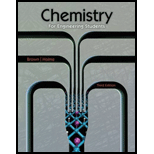
Concept explainers
Interpretation:
You work in a semiconductor production plant that relies on several chlorofluorocarbons in its manufacturing process. One day, you find an unlabeled gas cylinder, and you are assigned to figure out what is in the tank. First, you fill a 1.000-L flask with the gas. At a pressure of 250.0 torr and a temperature of 25.000C, you determine that the mass of the gas in the flask is 2.2980 g. Then, you send the flask to an outside lab for elemental analysis, and they report that the gas contains 14.05% C, 44.46% F, and 41.48% Cl by mass. The molecular formula of this gas should be identified.
Concept introduction:
An ideal gas which is known as the perfect gas is a gas whose volume V, Pressure P and temperature T are related through the
Here,
-
n = Number of moles of the gas
R = Universal gas constant
T = Temperature
P = Pressure
Ideal gases are described as the molecules which have negligible size but have an average molar kinetic energy which is dependent on the temperature. When temperature is low most of the gases behave like ideal gases and the ideal
Answer to Problem 5.88PAE
Solution:
Given:
Volume of gas taken= 1.000L
Pressure = 250 torr = 0.329 atm
Temperature = (25+273) K = 298K
Mass of the gas = 2.298g
Percentage of elements present in gas:
Explanation of Solution
The ideal gas equation is as follows:
Or,
Or,
Now, the percent composition of the given elements are:
Divide all with their molar masses to get the number of atoms of each element as follows
Now, divide with the smallest number to calculate the empirical formula:
So, the empirical formula is
Calculate empirical formula mass as follows:
Now,
Or,
Where,
Thus,
Therefore, the molecular formula is
Ideal gases are described as the molecules which have negligible size but have an average molar kinetic energy which is dependent on the temperature. Using the ideal gas equation, the calculated molecular formula of gas is
Want to see more full solutions like this?
Chapter 5 Solutions
Chemistry for Engineering Students
- Butyl mercaptan, C4H9SH, has a very bad odor and is among the compounds added to natural gas to help detect a leak of otherwise odorless natural gas. In an experiment, you burn 95.0 mg of C4H9SH and collect the product gases (SO2, CO2, and H2O) in a 5.25-L flask at 25 C. What is the total gas pressure in the flask, and what is the partial pressure of each of the product gases?arrow_forward97 Homes in rural areas where natural gas service is not available often rely on propane to fuel kitchen ranges. The propane is stored as a liquid, and the gas to be burned is produced as the liquid evaporates. Suppose an architect has hired you to consult on the choice of a propane tank for such a new home. The propane gas consumed in 1.0 hour by a typical range burner at high power would occupy roughly 165 L at 25°C and 1.0 atm, and the range chosen by the client will have six burners. If the tank under consideration holds 500.0 gallons of liquid propane, what is the minimum number of hours it would take for the range to consume an entire tankful of propane? The density of liquid propane is 0.5077 kg/L.arrow_forwardA chemist weighed out 5.14 g of a mixture containing unknown amounts of BaO(s) and CaO(s) and placed the sample in a 1.50-L flask containing CO2(g) at 30.0C and 750. torr. After the reaction to form BaCO3(s) and CaCO3(s) was completed, the pressure of CO2(g) remaining was 230. torr. Calculate the mass percentages of CaO(s) and BaO(s) in the mixture.arrow_forward
- Under which of the following sets of conditions does a real gas behave most like an ideal gas, and for which conditions is a real gas expected to deviate from ideal behavior? Explain. (a) high pressure, small volume (b) high temperature, low pressure (c) low temperature, high pressurearrow_forward99 Pure gaseous nitrogen dioxide (NO2) cannot be obtained, because NO2dimerizes, or combines with itself, to produce a mixture of NO2 and N2O4. A particular mixture of NO2, and N2O4 has a density of 2.39 g/L at 50°C and 745 torr. What is the partial pressure of NO2 in this mixture?arrow_forwardIf you have a 150-L cylinder filled with chlorine gas to a density of 2.8 g/L, how many moles of chlorine would you need to add to the cylinder? If you were to double the temperature of the cylinder, would the gas density change?arrow_forward
 Chemistry for Engineering StudentsChemistryISBN:9781337398909Author:Lawrence S. Brown, Tom HolmePublisher:Cengage Learning
Chemistry for Engineering StudentsChemistryISBN:9781337398909Author:Lawrence S. Brown, Tom HolmePublisher:Cengage Learning ChemistryChemistryISBN:9781305957404Author:Steven S. Zumdahl, Susan A. Zumdahl, Donald J. DeCostePublisher:Cengage Learning
ChemistryChemistryISBN:9781305957404Author:Steven S. Zumdahl, Susan A. Zumdahl, Donald J. DeCostePublisher:Cengage Learning Chemistry: An Atoms First ApproachChemistryISBN:9781305079243Author:Steven S. Zumdahl, Susan A. ZumdahlPublisher:Cengage Learning
Chemistry: An Atoms First ApproachChemistryISBN:9781305079243Author:Steven S. Zumdahl, Susan A. ZumdahlPublisher:Cengage Learning
 Chemistry & Chemical ReactivityChemistryISBN:9781337399074Author:John C. Kotz, Paul M. Treichel, John Townsend, David TreichelPublisher:Cengage Learning
Chemistry & Chemical ReactivityChemistryISBN:9781337399074Author:John C. Kotz, Paul M. Treichel, John Townsend, David TreichelPublisher:Cengage Learning Chemistry & Chemical ReactivityChemistryISBN:9781133949640Author:John C. Kotz, Paul M. Treichel, John Townsend, David TreichelPublisher:Cengage Learning
Chemistry & Chemical ReactivityChemistryISBN:9781133949640Author:John C. Kotz, Paul M. Treichel, John Townsend, David TreichelPublisher:Cengage Learning





